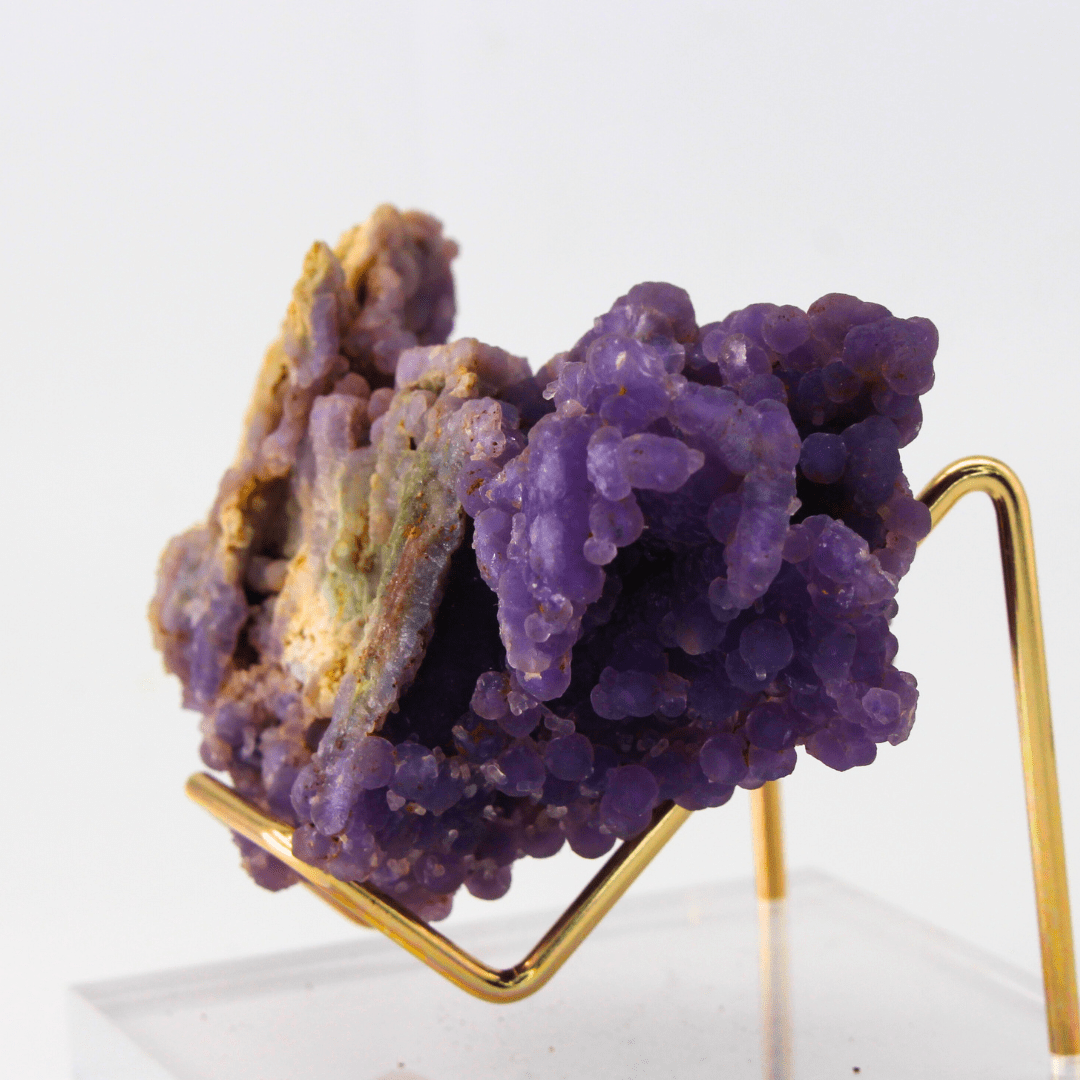SKU:GC218g
Grape Chalcedony Naturally Terminated Indonesia 218 Natural Mineral Specimen Fine Collectable Cabinet Display Piece Geological Interest
Couldn't load pickup availability
Grape Chalcedony Naturally Terminated Indonesia 218g
Grape Chalcedony Naturally Terminated Indonesia 218g is a carefully selected natural mineral specimen chosen for its visual impact, geological interest and overall display quality. Its natural formation reflects long-term mineral growth processes that have produced distinctive textures, surfaces and structural details. The specimen offers a refined interplay of form, colour and natural geometry, making it an excellent choice for collectors, interior settings and anyone seeking to introduce authentic geological character into their space.
Key Features
- Grape Chalcedony Naturally Terminated Indonesia 218g — hand-selected for aesthetic balance and natural formation
- Approximate dimensions height approximately 110mm, length approximately 64mm, width approximately 75mm, making it suitable for cabinet or shelf display
- graded as Excellent-ex; Uncirculated and certified as Genuine by Imperial Time UK Ltd
- Sourced with attention to accurate mineral identification and natural integrity
- Suitable for private collections, curated interiors and design-led spaces
- Reviewed and prepared by Imperial Time UK Ltd in Kensington, London
Formation & Mineralogy
Minerals of this type develop over extended geological timescales under specific combinations of heat, pressure and chemical environment. Variations in these conditions influence crystal habit, surface texture and internal structure, giving each specimen its own distinct character. Collectors value these natural variations for the insight they provide into geological history and for the visual diversity they introduce into a collection or interior scheme. The specimen’s surfaces, growth patterns and natural contours all contribute to its individuality and long-term interest.
Condition & Preparation
Every specimen offered by Imperial Time UK Ltd undergoes a detailed inspection and preparation process before being made available to clients. Our team examines surface integrity, matrix stability, natural terminations and any features relevant to display and handling. This specimen is graded as Excellent-ex; Uncirculated and certified as Genuine by Imperial Time UK Ltd, offering collectors confidence in its quality and presentation. Particular care is taken to ensure that the specimen presents well from multiple viewing angles and can be placed confidently within a cabinet, shelving arrangement or display plinth.
Provenance & Authenticity
Authenticity and provenance are important considerations when acquiring fine minerals. Imperial Time UK Ltd follows a structured verification process that includes visual examination, locality confirmation where available and comparison with established reference material. This approach helps ensure that each specimen aligns with recognised mineralogical characteristics and that clients can build collections grounded in accuracy and transparency.
What's Included
- Grape Chalcedony Naturally Terminated Indonesia 218g
- Professional assessment of condition, authenticity and display suitability
- Protective packaging designed to support safe, fully insured transport
- Option of worldwide shipping or collection from our Kensington showroom
About Imperial Time UK Ltd
Imperial Time UK Ltd is an established specialist in luxury watches, fine jewellery, coloured gemstones and rare minerals based in Kensington, London. Alongside our horological and jewellery expertise, we curate a selection of mineral and gemstone specimens that meet our standards for quality, authenticity and visual presence. We provide clear, client-focused guidance for both new and experienced collectors, as well as for interior professionals seeking distinctive natural accents.
Explore Our Gemstones
Clients interested in complementary pieces or broader collecting themes can explore additional gemstones and mineral specimens within our Gemstones section. Newly sourced items and notable additions are highlighted in our New Arrivals area, making it easy to review the latest pieces available from Imperial Time UK Ltd.
Basic Info
| Condition Description | Grape Chalcedony Naturally Terminated Indonesia 218g - Purple, Rough, Chalcedony - Luxury Wat — curated by Imperial Time UK Ltd in London Kensington. Discover |
| Condition | New |
| Color | Purple |
| Certification | Imperial Time UK Ltd |
| Case Size | 110mm |
| Short Description | Grape Chalcedony Naturally Terminated Indonesia 218g - Purple, Rough, Chalcedony - Luxury Wat — curated by Imperial Time UK Ltd in London Kensington. Discover |
| Year | 2024 |
| Width | 75mm |
| Vintage | No |
| Stone Colour Grade | D |
| Style | Loose Gemstones |
| Shape | Symbol |
| Secondary Stone | No Stone |
| Occasion | Birthday |
| Main Stone Treatment | Not Enhanced |
| Main Stone Creation | Natural |
| Main Stone | Chalcedony |
| Gemstone Form | Rough |
| Main Stone Colour | Purple |
| Seller Waranty | Yes |
| Number of Gemstones | 1.0 |
| Number of Diamonds | 0.0 |
| Material | Gemstone |
| Manufacturer | Imperial Time |
| Height | 110mm |









- Specifications
- Shipping And Return
Care Instructions: Regularly clean your jewellery to remove dirt, oils, and other residues that can dull its appearance. Use a soft, lint-free cloth to gently wipe the surface of the jewellery.
Customization Options: Allow customers to work with a jewellery designer to create custom pieces tailored to their specifications. This could include choosing specific gemstones, metals, settings, and design elements to create a one-of-a-kind piece.
Certifications and Authenticity: We provide certificates of authenticity and/or appraisal for our jewellery, depending on the item and its value. These certificates typically include information about the materials used, such as the type and quality of gemstones and metals, as well as details about the craftsmanship.
- Shipping costs are determined based on factors such as your location, the weight of your order, and the selected shipping method. You can view the shipping costs for your order during the checkout process.
- we offer international shipping to select countries. International orders may be subject to customs duties, taxes, and import fees, which are the responsibility of the customer.
- We want you to be completely satisfied with your purchase. If you are not satisfied for any reason, you may return your order within 30 days of delivery for a full refund or exchange.















